 Image search results - "uno" Image search results - "uno" |
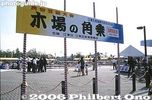
Kiba Park with Kiba Kakunori sign. Traditional folk performances are held on the same day as Koto Ward's Citizen's Festival in mid-Oct. So the park is quite crowded.
|
|
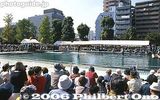
Huge crowd at Kakunori pond in Kiba Park.
|
|
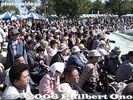
It starts at 11 am, so if you want a good view, go there early.
|
|

Kiba Sqaure Log Rolling is performed by the Kiba Kakunori Hozon-kai or Preservation Society. 木場角乗保存会
|
|

Kiba used to be where wood and lumber were stored and produced. 相乗り
|
|

Men managing the logs in the river eventually developed their own log tricks while on the job.
|
|

A long bamboo pole is used for balance.
|
|
|

Head stand
|
|
|

Mt. Fuji as seen from the train on the Itsukaichi Line in Akiruno.
|
|

Double head stands
|
|

Approaching Musashi-Itsukaichi Station
|
|

Without the bamboo pole, it is more difficult to keep your balance.
|
|

Approaching Musashi-Itsukaichi Station
|
|

Splash!
|
|

JR Musashi-Itsukaichi Station on the Itsukaichi Line
|
|

He tries again and succeeds in unfurling a banner which says "Koto Ward, Water Capital."
|
|

JR Musashi-Itsukaichi Station on the Itsukaichi Line
|
|

Woman roller.
|
|

In front of JR Musashi-Itsukaichi Station
|
|

Log rolling lessons are given at a local pool. Lot of children are good at it. I tried it once too. Very difficult...
|
|

In front of JR Musashi-Itsukaichi Station (bus stops)
|
|

The middle of the foot must land on the corner to turn the log.
|
|
|
|

Rolling with a fan. 扇子乗り
|
|

Rolling blindfolded.
|
|

Blindfolded head stand.
|
|

Rolling with geta clogs. 駒下駄乗り
|
|

The middle of the geta clog must land right on top of the log's corner.
|
|

Preparing for a head stand.
|
|
|
|
|

Rolling with an umbrella. 唐笠乗り
|
|

Father and son. He later turned around and rolled the other way with his son on his shoulders.
|
|

Acrobatics on a floating ladder. 梯子乗り
|
|

Ladder stunts
|
|
|
|
|

A real crowd pleaser.
|
|

The kanji "ki" (wood) is written on the his back on the left.
|
|

The logs are moved around with a spike-tipped bamboo pole.
|
|

One of the highlight stunts...
|
|
|
|

This year (2004), it was successful.
|
|

However, it is always possible that they splash down.
|
|

Another highlight and difficult stunt.
|
|
|
|
|
|

From the top of the blocks, he's supposed to jump onto the log in front. But he couldn't do it.
|
|

Another guy tries to do it.
|
|
|
|

He succeeds.
|
|
|
|

Sign for Chichibu-Tama-Kai National Park
|
|

Ending chant. The performance is about 90 min.
|
|

View from Ochiai Bridge
|
|
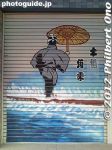
Store shutter art of Kiba kakunori in Koto, Tokyo.
|
|

Lookout deck over the gorge
|
|
|

Bridge over the gorge
|
|

Some kind of bridge is being built at one end of the gorge.
|
|

Akikawa River
|
|

Akikawa River
|
|

Clear waters
|
|

Pussy willow growing along the river.
|
|

Oiwake bus stop, near the gorge.
|
|

Tokyo Millenario was a brilliant sculpture of light mounted over a street in Marunouchi near Tokyo Station. From 1999 to 2005, it was held during the last week of the year until New Year's Day. The event was discontinued after 2005 due to constructioTokyo Millenario was mounted over a small street in Marunouchi called Marunouchi Naka-dori during the last week of the year. It lit up from 5:30 pm to 9 pm and on Jan. 1 (the last day), from midnight to 3 am. It became a major winter attraction, with over 2 million visitors in 2004.
The crowds were horrendous. It took 40 min. or longer just to get in. Photo: 5:05 pm: At the back of the line.
|
|

5:16 pm: Our line merges with another one coming from Tokyo Station
|
|

Behind us
|
|

"Red light ahead, please stop..."
|
|

5:34 pm: Entrance in sight
|
|

Title of work: "Corolle Liberty" by Valerio FestiThe artist is Italian.
|
|
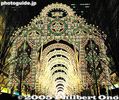
Entrance. The entrance gate is 22 meters tall and 19 meters wide.
|
|
|
|

5:40 pm: Entered Tokyo Millenario street
|
|
|
|
|

Back of entrance
|
|
|

"No stopping please..."
|
|

Less crowded at the end. After you pass through the main street, there are more decorations on the side street. You can also backtrack on the main street along the sidewalk only.So if you want to see the Millenario really quickly and don't mind not being in the middle of the street, go on the sidewalk.
|
|
|
|

"Quadrifogli " (Clovers of Light) at Tokyo Station
|
|

Tokyo Station
|
|

Honden roof
|
|

Side gate to Honden
|
|

Side gate
|
|

Side gate roof
|
|

Tokugawa crest
|
|

Honden Hall of Kunozan Toshogu Shrine at Nihondaira, Shizuoka. The shrine's focal point and most magnificent building. Important Cultural Property.
|
|

They repaint and lacquer the shrine only once every 50 years. It takes several years to complete the job and they just finished it in 2006.
|
|

The shrine looks spanking new and the colors are very impressive. It cost 1,300,000,000 yen to restore the lacquer and paint.
|
|

Lion dog painting on the Hionden Hall.
|
|

Honden Hall roof
|
|

Roof corner
|
|
|
|
|
|
|

Carving
|
|
|
|
|
|
|
|
|
|
|
|

Honden Hall
|
|
|
|
|
|

It takes about 30 processes to restore the lacquer.
|
|

Plexiglass protects the lower carvings.
|
|

Karamon Gate door carving
|
|

View from Karamon Gate
|
|

Honden Hall
|
|
|
|
|
|

Gate to Tokugawa Ieyasu's tomb is also an Important Cultural Property. 廟所
|
|
|
|
|

Approach to Ieyasu's tomb
|
|

Tokugawa Ieyasu's tomb at Kunozan Toshogu
|
|

Tokugawa Ieyasu's tomb at Kunozan Toshogu. The tomb actually faces west, toward Okazaki in Aichi Prefecture where Ieyasu was born. 神廟
|
|
|
|

Tokugawa Ieyasu's tomb at Kunozan Toshogu
|
|
|
|
|
|

Kunozan Toshogu Shrine Museum has about 2,000 pieces in its collection of mostly everyday things used by Ieyasu and other Tokugawa shoguns. Besides swords, there are Western articles. 博物館
|
|

Inside Kunozan Toshogu Shrine Museum, articles belonging to Ieyasu are displayed. If you're Spanish, you'd be interested in seeing the Spanish clock owned by Ieyasu. Admission charged.
|
|
|
|
|

Lookout deck
|
|

View from lookout deck
|
|
|
|
|

Gate keeper station 門衛所
|
|

Stone steps going down to the coast. It takes about 20 min. to go down these stone steps to the bottom. There are 1,159 stone steps which don't mean much unless you're climbing up.
|
|

It might take at least 30 min. to go up these steps, 1,159 steps spanning 760 meters with 17 switchbacks.
|
|

Nice view from the stone steps. Those vinyl houses are growing strawberries which are sold everywhere at the foot of Kunozan during Jan. to May.
|
|

Stone steps 石段
|
|

Plum garden marker
|
|

Plum garden marker
|
|

Plum trees
|
|
|
|

Stone torii 山下石鳥居
|
|

Torii with Kunozan in the background.
|
|

Parking area for people going to Nihondaira via the steps up the mountain. Near here is the bus stop for Shizuoka Station.
|
|
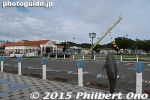
Back at Uno Station in Okayama.
|
|
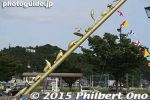
Uno Station in Okayama.
|
|
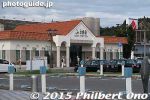
Uno Station in Okayama.
|
|
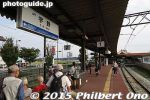
Uno Station platform.
|
|
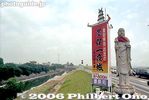
Road to Sunomata Ichiya Castle. "Ichiya" means "one night," referring to how long it took to build the castle according to legend. Phone: 0584-62-3322, Address: 岐阜県大垣市墨俣町墨俣1742-1
|
|

Gate to Sunomatawhich was also a post town along the Mino Road. Sunomata is accessible by Gifu Bus (W65 on Obusa Sunomata Route) from JR Gifu Station and Ogaki Station. Get off at Sunomata bus stop.
|
|

Another gate along the path to Sunomata Castle.
|
|

Way to Sunomata Castle. This path goes along the Nagara River.
|
|

Sunomata Castle was originally built in 1561 by Toyotomi Hideyoshi supposedly overnight as part of Oda Nobunaga's strategy to conquer Mino (Gifu) Province.
|
|

Sunomata Ichiya Castle was reconstructed in April 1991.
|
|

Main bridge to Sunomata Castle. Gourds are prominent here.
|
|

Sunomata Castle
|
|

Sunomata Castle and gourd sculpture. The gourd (hyotan) was Toyotomi Hideyoshi's trademark as well as a symbol of this area.
|
|

Sunomata Castle.
|
|

Bridge to Sunomata Castle.
|
|

Sunomata Ichiya Castle is open 9 am to 5 pm, closed Mon. (open if a national holiday and closed on Tue. instead). Admission 200 yen for adult, free for children below age 18.
|
|

Statue of Toyotomi Hideyoshi in front of Sunomata Castle.
|
|

Statue of Toyotomi Hideyoshi in front of Sunomata Castle.
|
|
|
|

Golden pair of shachi atop Sunomata Castle.
|
|

Entrance to Sunomata Castle.
|
|

Near the castle entrance is this stone gourd pouring water.
|
|

Small sculptures on the castle foundation.
|
|

Side view of Sunomata Castle.
|
|

Rear view of Sunomata Castle.
|
|

Another bridge to Sunomata Castle. More picturesque, but almost useless as it goes to a road with heavy traffic.
|
|

Stone foundatio.
|
|

Roof
|
|

Sunomata Castle has five floors. The first floor has this room introducing the nature and history of Sunomata.
|
|

This room was also where Crown Prince Hiro and Crown Princess Masako rested during a visit to the castle in April 1995.
|
|
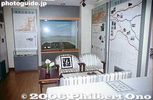
When I visited the castle in 1995, the room still had the chairs and table the Crown Prince and Princess used. They have since been removed from the room. This photo was taken in 1995.
|
|

Model of Sunomata which was a post town on the Mino Road between Atsuta in Nagoya and Tarui in Gifu.
|
|

The castle is small, but nice. The stairway here.
|
|

The second floor shows how the castle was built.
|
|

Video screening area.
|
|

Rest area.
|
|
|

The 3rd floor shows how Toyotomi Hideyoshi rose to power and prominence.
|
|

Toyotomi Hideyoshi
|
|
|

Swords
|
|

Matchlock guns
|
|
|
|
|

Print showing the construction of Sunomata Castle.
|
|

The fourth floor is a gallery. Pictures by local kids.
|
|
|
|

"Hideyoshi" in kanji spelled out with small gourds.
|
|

The 5th floor is the lookout deck. No veranda, but the windows are open for easy viewing and picture-taking.
|
|

View of Nagara River.
|
|

View of Sunomata and the main bridge to the castle.
|
|

View of Sunomata-juku post town.
|
|
|

On a clear day, Mt. Ibuki can be seen.
|
|

Nagara River and Gifu Castle on Mt. Kinka on the upper left.
|
|

Gifu Castle atop Kinkazan as seen from Sunomata Castle. Then called Inabayama Castle, Gifu Castle was one objective for Sunomata Castle and Hideyoshi.
|
|

View of Shirahige Shrine
|
|

Sunomata Castle marker.
|
|

Marker commemorating the Crown Prince and Princess' visit in April 1995.
|
|
|

Shirahige Shrine is next to Sunomata Castle.
|
|

Next to Shirahige Shrine is Hokoku Shrine dedicated to Hideyoshi.
|
|

Hokoku Shrine is called the home of the "God of Success" in reference to Hideyoshi's spectacular rise to power from humble beginnings.
|
|

About Hokoku Shrine.
|
|

Next to the castle is also this rack of gourds.
|
|
|

Graves of those who died building Sunomata Castle.
|
|
|

Kiba Kakunori Monument for square log rolling 角乗り碑
|
|

Kiba Kakunori Monument for square log rolling 角乗り碑
|
|

Opened in 1914, Tokyo Station is Japan's main train station and has been undergoing major renovations. The red brick station building on the Marunouchi side has been restored with the original roof domes.
|
|

Tokyo Station unveiled its fully-restored Marunouchi building on Oct. 1, 2012 after taking several years. To appreciate the extent of this splendid restoration, I've included photos of what it looked like before.
|
|
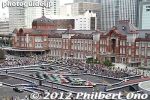
Tokyo Station has two main entrances/exits: Marunouchi and Yaesu. Both sides are undergoing a major transformation.
|
|
|
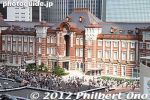
Tokyo Station's Marunouchi North entrance in Oct. 2012. Lot of people were there gazing and taking pictures of the restored building.
|
|
|
|

Old Tokyo Station, Marunouchi side. On the left end is the North Entrance under a dome roof, and on the right end is the South Entrance also under a dome roof. Both dome roofs were damaged during World War II, and were repaired with slat-style roofs.
|
|
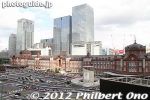
The new Tokyo Station with original domes restored. See more before and after photos below.
|
|

Tokyo Station, Marunouchi side. This side faces the Imperial Palace and the Otemachi business district.
|
|
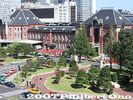
Tokyo Station, red brick building. The large center entrance also has a dome, but it is not used. The center entrance for the public is off to the left side (very small). 赤レンガビル
|
|

Tokyo Station, Marunouchi North Entrance dome in 2007.
|
|
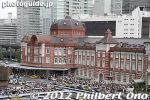
Tokyo Station, Marunouchi North Entrance dome in Oct. 2012.
|
|
|
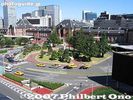
Area in front of Tokyo Station, Marunouchi side
|
|
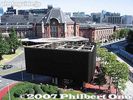
Tokyo Station, Marunouchi South Entrance
|
|

Twin towers on Yaesu side overlook the red brick building.
|
|
|
|
|

Center of red brick building, what should be the central entrance.
|
|
|
|

Driveway to central entrance.
|
|
|
|